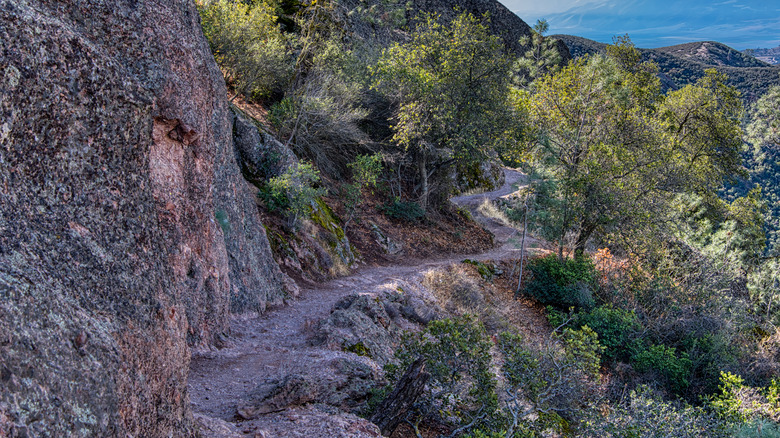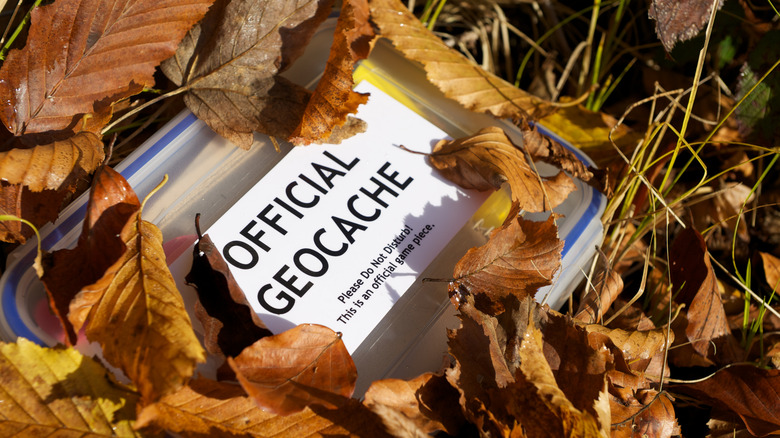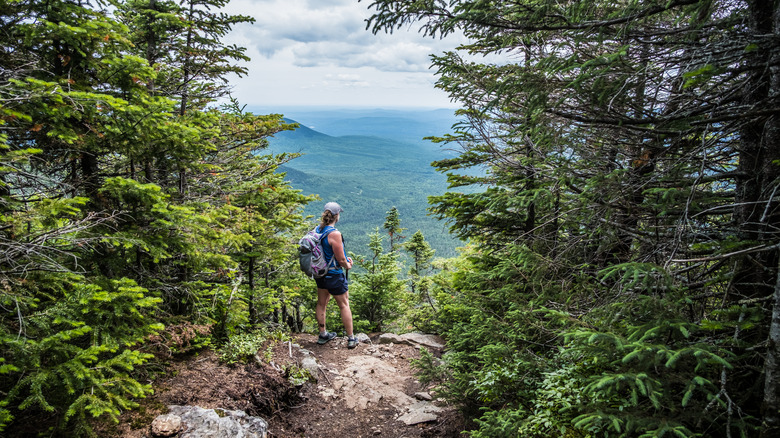Hiking Terms You Need To Know Before Your Next Adventure
In the United States, hiking for recreation truly began to take hold in the early 1900s. Outdoor recreation in general was becoming more and more fashionable as the automobile and scenic road trips made the vast country that is the United States so much smaller. Plus, with the invention of the National Parks, Americans became more interested in exploring the natural wonders that make up our nation. As more people took to the trails, a lingo developed over the decades and has been used to describe things ever since.
Like learning how to drive or figuring out a new software system your company installed, there are fundamental terms that everyone who goes hiking should know about. Rest assured, this isn't some hyper secret language that only those "in the know" are aware of. No, there are universal terms that all hikers will find useful on their adventures.
While you could fill an Oxford-sized dictionary with every single hiking term that has been developed over the last hundred years, there are a few essentials everyone should know before they hit the trails. The 12 terms we are about to provide you with are those you will hear most often when you're out on the trail.
Access road
Unless the trailhead you are looking for has its parking area directly off of a main roadway, you are likely going to have to take an access road to reach it. Typically unpaved, access roads serve a singular purpose: they provide access to the trailhead. There are varying degrees of access road. Some stretch on for miles, while others are not really much longer than a driveway. Regardless of size, however, their purpose remains the same.
While many will drive the access road to access the trailhead, these roads also serve another vital function in terms of access. In the event of an emergency, access roads provide emergency vehicles with the space they need to get as close as possible to the trail itself. The closer help is to you in case something goes wrong, the better off you will be.
Still, most will use an access road to find their way to the trailhead they're looking for. Now, there are some access roads that can take drivers up the side of a mountain for better views and an easier journey. These are typically paved, and will only be available on mountains with relatively shallow elevation.
Backcountry and frontcountry
We lump these two terms together because they are like siblings with different personalities. At its most basic, the term backcountry stands for the type of wilderness that can only be accessed via foot. Think the Great North Woods in Maine, or the side of Alaska portrayed in "Into the Wild." It's a place where there is very little in the way of civilization, and it is incredibly hard to access with a vehicle. It stands in stark contrast to its sibling.
Frontcountry, meanwhile, is more established. It is the kind of trail that can be accessed easily from urban or suburban environments. Think of a rail trail that passes through towns or the little river trail that goes along the waterway behind your work building. Most of these trails come with parking lots and are typically the result of some kind of government or private development.
Now, there are trails that can be a mix of both back and frontcountry. The Appalachian Trail is one such example. There are sections of that trail that are far off in the backcountry, then there are those sections that cut through towns and are much closer to civilization. When hiking, you will be able to tell the difference between the two. If it took you three hours down some ancient logging road to find your trailhead, you're in the backcountry. If you can cross the street and hop on a trail, that's frontcountry.
False summit
Of all the terms on this list, this one has to be the most aggravating. False summits are one of the most difficult things for a hiker to come to terms with. Imagine spending hours and copious amounts of energy climbing a mountain, only to find out that what you thought was the summit is only the halfway point? That is the infuriating reality of a false summit.
One such example of a false is the summit cone on a trail up Mount Washington in New Hampshire. Reaching the summit cone takes you on a very steep section of a trail up the mountain. Switchbacks and screes (which we'll get to) bring you to the rocky outcrop of the summit cone, which provides a clear view of the beautiful Lake of the Clouds, as well as Washington's final summit.
A trail can have several false summits, but you always know which one ends up being the last summit because you'll be greeted with a 360 degree view and no taller summits nearby. The only way to get over a false summit is to power through and keep going.
Ridgeline
If you've ever drawn a mountain with a pencil, the part that you draw upwards that crest towards the peak is what is known as the ridgeline. Now, ridgelines can be a bit more difficult to identify in reality than on paper. A lot depends on the type of mountain you are hiking. Traditional definitions have ridgelines as a section of a hiking trail that is very thin and runs along a mountain or hill and has a very steep drop on one or both sides. You're not going to find a ridge, say, on the riverwalk you take at the park during your lunch break.
Another term used to describe these types of trails is referred to as "knife's edge." One of the most famous knife edge trails in America is the trail literally called the Knife Edge that runs up Mount Katahdin in Maine. Other noteworthy ridgeline trails include Sugarland Mountain in Great Smoky Mountains National Park, and the Skyline Divide in Washington state. However, you're far more likely to find an epic ridgeline trail in Europe.
Of the many places you could hike in Europe, the Alpine trails in Italy, Switzerland, and Austria have to be some of the most dangerous and thrilling. Sure footing is needed on these incredibly steep mountainsides. One slip, and you could very well find yourself plummeting down a long, rocky fall that could actually take your life.
Scree and talus
Many hiking trails, especially those that go up the sides of mountains, are built to make sure that the ground beneath the hiker's feet is as secure as possible. However, there is only so much trailblazers can do, because, at a certain point, nature becomes too difficult to manage. Such is the case with screes and talus'.
A scree is an elevation of loose, smaller rocks on a slope. They are almost like the gravel driveway leading up to your cabin in the woods, only a scree is composed of much larger rocks and is far steeper. Careful footing is required when navigating a scree. Because of the loose nature of the ground beneath your feet, every step needs to be calculated so as not to loosen the ground even further.
A talus is similar to a scree in that it is an elevated slope composed of rocks, only the rocks that make up are larger fallen rocks and boulders that have been there for hundreds, if not thousands of years. A talus can be both easier, and more difficult, to navigate than a scree. It is easier in the sense that the path could just be lined with boulders, but you won't necessarily have to climb over any of them. Things get more difficult if you need to scale some larger rocks in order to get where you want to go.
Switchback
Switchback refers to the type of looping, zig-zagging trails that shimmy their way up the side of a mountain. These are used to manage the energy required to scale the mountain, and are commonly installed on ones that are far too steep to tackle directly. The importance of switchbacks is that they work with the landscape as opposed to cutting through it.
A switchback trail works by cutting along the side of the mountain at shallower angles, and turning sharply to the left or right, making almost a full turn. They continue up the mountain in this same fashion until a level surface is reached. The pitch of the switchback is often far less steep than the mountain it is scaling. The number of switchbacks depend largely upon how steep the mountain is and how high it goes.
If the trail you are climbing seems to cut constantly at shallow angles that seem to go on forever, it is very likely the mountain you are climbing is incredibly steep. Switchbacks are not usually installed on a mountain that has less than a 20% grade in elevation. The idea is to make the climb easier and more gradual, which would not be the case if you were to try and take on the mountain directly.
Treeline
If you're hiking any kind of elevation, you are going to reach a point where the woods become thinner and thinner and thinner. Then, suddenly, there are no trees left surrounding you. While you might not realize it while you're there, when you step back and take things at a distance, you'll realize that you have just reached what hikers and geologists call the treeline.
Also called a timberline, treelines simply refer to the literal lines made on a mountain above when trees cannot grow. There are a lot of factors that make a tree line, but what is constant is that as elevation increases it becomes increasingly difficult for any kind of substantial vegetation to grow. Most of what you'll find will be scrub bushes and other low growing plants that are protected from the increased winds by the rocks. Any trees you find at higher elevations are not likely to be as tall as those you'll find at lower ones.
At a distance, you will be able to gauge a treeline incredibly well. If you stand and look out across the surrounding hills, you will be able to see a clear line on the mountainside showing where the treeline is cut off. It's always best to try and tackle a treeline hike earlier in the day. If you need to make camp, you're more protected under the shelter of the canopy.
Bivouac
There is a chance that you have heard this term before, but don't know exactly what it means. This is because it actually has a few different meanings. To bivouac means to set up an emergency campsite. It's the type of site that is created by what is had on hand and what is available in the forest. This could mean stinging up the emergency tarp you have in your backpack, or making a shelter out of branches and rocks. It's the type of quick thinking maneuver that will keep you safe should an emergency strike.
Bivouac can also stand for a type of ultralight hiking sleeping bag. Often called a bivy bag, this sleeping bag is designed to provide optimal shelter with very little space. Think of it as a single person tent meets a sleeping bag. The lower portion of the bivy bag is like a standard sleeping bag, while the top is more tent shaped, and can become fully enclosed to protect your head.
This is more modernized bivouacking, and can be used by any hiker, but will most likely come in handy for those traveling long distances by foot. Still, if you do a fair amount of hiking, it may be worthwhile to carry a bivy bag in your pack just in case you need to make camp suddenly during your trip.
Cairn
We've all seen these rock structures, although we may not always have known what they are called. Cairns are small rock towers that are constructed by stacking smaller stones atop larger ones on a successive pattern. Traditionally, cairns were constructed as markers for distance along trails. More recently, however, they have been used for scenic photo shots because of the appealing nature of their shape.
Unfortunately, while we may see cairns every which way on a hiking trail, there are plenty of good reasons not to make one yourself. Cairns are extremely discouraged and, in some cases, even banned from being constructed. This is due to the fact that the rocks hikers are removing from the landscape to construct their cairns actually serve a purpose to the structural integrity of the ecosystem. In many cases, cairns actually do more harm than good.
As such, hikers are thoroughly discouraged from building cairns. Obviously, you can't do anything about the ones that are already there, but you should not seek to damage the environment any farther. The removal of rocks could lead to rock or landslides and looser surfaces, neither of which is good for the environment or for fellow hikers.
Cache
This is another term that could have multiple meanings, but the basic definition of a cache is a type of waterproof, tin box that contains items left behind by other hikers. Used by the military and early hikers as a method of food storage, caches would often be left at strategic checkpoints along the trail. However, food storage is discouraged these days because they make for more bait for bears and foxes. The less of these dangerous animals you run into while hiking, the better.
Still, it is worth understanding what the term means owing to a popular outdoor activity known as geocaching. Essentially, a cache is filled with special items left behind by other hikers, and the coordinates of which can be found via app or through use of a map or GPS. It's kind of like a modern day treasure hunt because you never know exactly what you are going to find inside of a cache.
Most of the time, what's inside is a little trinket or memento from the previous person. When a hiker finds a geocache, they are encouraged to either take something from the cache and replace it, of same or greater value. It is a fun way to break up the monotony of a hike.
LNT (Leave No Trace)
LNT, or Leave No Trace, refers to a series of outdoor ethics and trail etiquette that are designed to promote minimal impact on the surrounding environment. On their website, Leave No Trace states their 7 principles as: Plan Ahead and Prepare, Travel and Camp on Durable Surfaces, Dispose of Waste Properly, Leave What You Find, Minimize Campfire Impacts, Respect Wildlife, and Be Considerate of Other Visitors. The goal is to create a better shared experience for everyone who visits a trail.
Apart from creating a welcoming environment, there is an environmental aspect to LNT as well. This is more clearly displayed in the Leave What You Find, Proper Waste Removal, and Respect for Wildlife. The idea of hiking is to enjoy nature and do as little exterior damage to it as possible. This means leaving the landscape alone by sticking to the trail, not building cairns, and leaving sticks where they are. Also, keeping a distance from and not feeding wildlife is another major principle.
While LNT is meant to apply to all hiking trails, there are some that will let you know they take the principles seriously. Some trailhead maps will have LNT stickers on the legend, while services like the National Parks have a broad sweeping LNT rule that they display across all of their literature. But no matter where you are, it is good to know this term and be respectful of its use.
Thru-Hike
Finally, we have a term you will hear very often in hiking circles: thru-hike. A thru-hike is meant to refer to a trail that is long distance. A long-distance trail is one of those things that could take days or weeks to complete. Some of the most famous trails in the U.S. such as the Appalachian Trail and Pacific Crest Trail are thru-hikes. They are connected by a series of smaller hikes and trails to create one large trail with a terminus at each end. The hikers who try to attempt these trails are known as thru-hikers.
These types of trails are best tackled by those who have an excellent amount of experience when it comes to hiking. Thru-hikers are serious about their hiking and like to test the limits of what their body is capable of. Of course, this also means that a lot of extra preparation and planning needs to happen if you're looking to embark on a thru-hike.
You would do well to look up some extra terms just to be in the know about a lot of things on the trail. However, the 12 we've listed here are going to give you a rudimentary knowledge of what exactly you need in order to have a successful hike, and understand some of the lingo you'll hear out on the trail.












